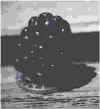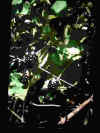| July
Talk about your favorite season,
An’ I’ll up and tell you mine . . .
Without fancy words or phrases:
It’s just ol’ blackberry time.
In the days of 30-something Fords and Chevies life was a laid back thing,
but through the warm months--including the dog days of summer--folks still
had to prepare for winter.
This meant big gardens to produce Irish potatoes, sweet potatoes, onions,
green beans, tomatoes and other veggies that could be kept by canning or
underground storage for the winter staples of county life.
But it also meant harvesting and preserving wild berries--especially
blackberries and their next of kin, dewberries. When dewberries ripened
in the early days of July--blackberries were hot on their heels--these
succulent black beauties became the focus of most households in Southern
Indiana.
Picking berries was a family activity. It was not a voluntary thing.
After supper on the eve of the big family blackberry-picking excursion
(usually to the pin oak thickets on the New-Cut Road west of Crothersville
(my old hometown), my dad would announce that “we are going to pick berries
tomorrow.” The “we” meant every member of the family. When the dew
had dried the next morning, the entire family--excluding my aged grandmother--would
be in the woods with pails.
One year my older brother, who thought he was old enough to exercise
the option of having a mind of his own, said he did not think he would
participate. "That is fine,” my dad said sternly. “But if you don’t pick
now you do not eat blackberry cobbler and pies in the winter.” Whether
it was the thought of forgoing blackberry jelly, jam, cobbler, pie or the
poor-man’s dessert (canned blackberries on a hot, buttered biscuit topped
by canned berries) I do not know. But the thought of having to live without
those delicacies undoubtedly changed my brother’s priorities and thinking
in a hurry. He picked with the rest of the family.
My dad never owned an automobile, but one of his jobs with the Vincennes
Packing Company (Crothersville factory) was driving a truck. This required
that he wear a brass chauffeur’s license tag on his old leather cap while
driving a company truck. But my dad, a tall thin man who was known
to people of our town as “Hickory,” walked nearly everyplace he went. I
thought there was a smack of disdain for motor-driven vehicles when he
would tell me: “if we keep building more cars and roads, men will someday
be born without legs.”
Transportation to the berry patch was most often provided by Garland
“Big Mitch” Mitchell, an outdoor mentor of mine, in his father’s old open
touring car, a Chevy, I believe. If we had to walk the three miles
to the berry patches, we carried buckets and pails that would hold from
one to three gallons of berries. This meant a misstep in the patch, or
on the trek home, could cause a dreaded berry spill.
If Big Mitch took our family to the berry patches, a small washtub was
used as a common container. This meant each member of the family could
fill his/her pail more than once. And we did, especially when berries in
the thickets were as big as the first joint of a man’s thumb and as sweet
and juicy as a ripe watermelon.
The day after a successful berry-picking, the kitchen was a beehive
of activity as several gallons of the black beauties would be turned into
jelly, jam, cobblers,
pies and simply canned in quart Ball jars with real (gasp!) lead screw-on
lids and real rubber rings that assured a tight seal.
When the berry season ended, our pantry would be blessed with 50 quarts
or more of canned, sweetened berries (my mother bought sugar in 25-pound
muslin bags). Empty sugar bags were washed and used many times for straining
off berry juice for jelly, and separating wild honey from the comb in the
dead of winter (the time when bee trees were cut).
When the sun headed south late in the summer, the family larder also
would be stocked with hundreds of jars of our garden’s produce, including
both pint and quart jars of chili sauce, a combination of tomatoes, pickles,
corn (cut from the cob), green peppers, and I don’t know what else), and
a sweet relish made from green tomatoes, corn, cucumbers, and other veggies.
There was, of course, the perennial report of a huge snake being sighted
crossing the New Cut Road as it moved from one thicket to another. One
could never pin down exactly who saw the snake, but a walk down the New
Cut would reveal marks in the gray clay dust-- prima facie evidence of
the snake’s authenticity.
The snake stories did not quell berry picking activities of my family
. . . nor did they keep me out of the selfsame thickets with my little
single-shot Springfield .22 when squirrel season opened at mid-August.
Jack Cain, one of my hunting/fishing mentors of that era, had a plausible
explanation for the undeniable facts that something quite large had crossed
the road in several places, leaving telltale tracks in the powder-fine
dust.
Jack opined that anybody could make tracks like that with an old inner
tube (automobile inner tube). It is not totally unlikely that Jack’s thoughts
held credence . . . a ploy designed to keep other berry pickers shy of
the area. However, simple practical jokes were not beyond the realm
of reality in rural Indiana in that day.
I didn’t always wait for the family berry-picking outings to get started.
With dewberries (a member of the blackberry family) selling at 35 cents
a gallon to those who had more money than ambition, and a going price of
25 cents for blackberries, an enterprising boy could pick up enough change
to buy a big sack of fireworks, or a fly-specked artificial lure at the
corner drugstore.
BLACKBERRY, DEWBERRY?
Blackberries and dewberries are a part of the rubus family, which
includes raspberries. Berries of the two are much alike, but there the
similarities end.
Blackberries grow on canes that can reach high into brush and small
trees, while dewberries vines ramble through weeds of fallow fields or
in the brush of fence rows, seldom reaching more than two or three feet
above the earth.
The berries of dewberry plants are more rounded than those of the blackberry
and they ripen earlier. The fact that dewberries develop and ripen in shade
seems to make them more juicy and sweet than their cousins.
However both berries are made up of clusters of seeds, each tiny seed
being imbedded in a sweet juice inside a tender skin. Both berries are
easily crushed. The canes of blackberries, like those of black raspberries,
are said to live only two years, bearing berries only in the second year.
Dewberry vines are much hardier and may produce berries for several years.
Although the juice of black raspberries is reddish (I liken it to the
throat of a male ruby-throated hummingbird) it produces wines that are
more black than red and jellies that are considerably more black.
Click on
thumbnail photo to see enlarged image.
 |
 |
 |
| Image
1: Blackberries and dewberries, like black raspberries develop green in
color then turn red before turning black when ripe. |
Image
2: This dewberry covered a quarter and was sweet and juicy. |
Image
3: Dr. Barth Wheeler picked blackberries often with his children--Jennifer
and Brett--when they lived at Huntington, Ind. Note upright canes, the
mark of a blackberry plant. |
 |
|
 |
| Image
4: The blackberry/dewberry mix of six berries covered six inches on a ruler
and helped fill my pail quickly. |
|
Image
5: Dewberry vines ramble through low weeds and the berries often ripen
in the shade to keep them sweet and juicy. |
|

